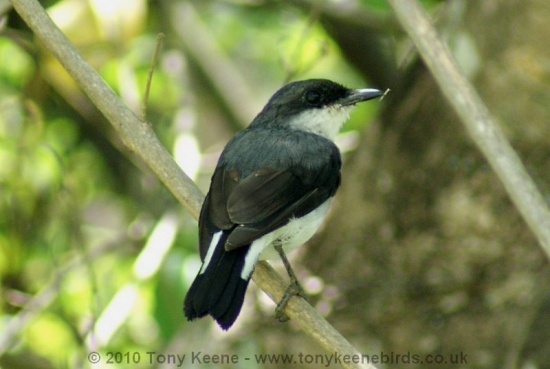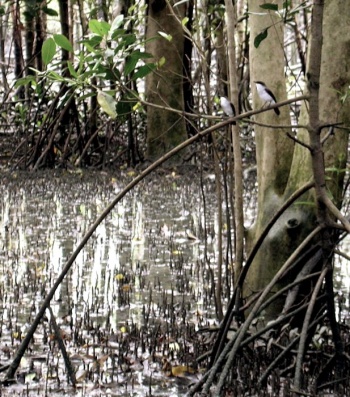m (removed incomplete template) |
(genus change) |
||
| Line 1: | Line 1: | ||
[[Image:Mangrove_robin_2.jpg|thumb|550px|right|Photo by {{User|colonelboris|colonelboris}}<br/>Cairns, [[Queensland]], [[Australia]]]] | [[Image:Mangrove_robin_2.jpg|thumb|550px|right|Photo by {{User|colonelboris|colonelboris}}<br/>Cairns, [[Queensland]], [[Australia]]]] | ||
[[Image:Mangrove_Robin.jpg|thumb|350px|right|Photo by [http://www.birdforum.net/member.php?u=16212 Mat & Cathy] <br/>Palmerston, [[Northern Territory]], [[Australia]]]] | [[Image:Mangrove_Robin.jpg|thumb|350px|right|Photo by [http://www.birdforum.net/member.php?u=16212 Mat & Cathy] <br/>Palmerston, [[Northern Territory]], [[Australia]]]] | ||
| − | ;[[:Category: | + | ;[[:Category:Peneoenanthe|Peneoenanthe]] pulverulenta |
| + | ''Eopsaltria pulverulenta'' | ||
==Identification== | ==Identification== | ||
A small grey and white robin with a darker eyestripe and black T-shape on the tail with white flanks. The four different races have slightly different greys on the back and crown. They are silent in flight, but have a range of calls: a two-note whistle; hard 'chuk' or 'chit'; falling 'pee-pee-peer'. 14-16 cm. | A small grey and white robin with a darker eyestripe and black T-shape on the tail with white flanks. The four different races have slightly different greys on the back and crown. They are silent in flight, but have a range of calls: a two-note whistle; hard 'chuk' or 'chit'; falling 'pee-pee-peer'. 14-16 cm. | ||
| Line 8: | Line 9: | ||
==Taxonomy== | ==Taxonomy== | ||
| − | + | Placed in genus ''[[:Category:Eopsaltria|Eopsaltria]]'' by some authorities. | |
==Habitat== | ==Habitat== | ||
Tropical mangrove forests | Tropical mangrove forests | ||
| Line 17: | Line 18: | ||
"The Slater Field Guide to Australian Birds, 2nd Edition", P. Slater, P. Slater and R. Slater, Reed New Holland, 2009, ISBN 9781977069635 | "The Slater Field Guide to Australian Birds, 2nd Edition", P. Slater, P. Slater and R. Slater, Reed New Holland, 2009, ISBN 9781977069635 | ||
==External Links== | ==External Links== | ||
| − | {{GSearch| | + | {{GSearch|Peneoenanthe+pulverulenta}} |
*[http://www.aviceda.org/abid/birdimages.php?action=birdspecies&fid=65&bid=1071 View more images of this species on the ABID] | *[http://www.aviceda.org/abid/birdimages.php?action=birdspecies&fid=65&bid=1071 View more images of this species on the ABID] | ||
| − | [[Category:Birds]][[Category: | + | [[Category:Birds]][[Category:Peneoenanthe]] |
Revision as of 10:15, 2 April 2011
- Peneoenanthe pulverulenta
Eopsaltria pulverulenta
Identification
A small grey and white robin with a darker eyestripe and black T-shape on the tail with white flanks. The four different races have slightly different greys on the back and crown. They are silent in flight, but have a range of calls: a two-note whistle; hard 'chuk' or 'chit'; falling 'pee-pee-peer'. 14-16 cm.
Distribution
There are four subspecies: cinereiceps (northern WA) and alligator (NT) are endemic to Australia, pulverulenta occurs in Indonesia and Papua New Guinea while leucura occurs in Papua New Guinea and north-eastern Queensland.
Taxonomy
Placed in genus Eopsaltria by some authorities.
Habitat
Tropical mangrove forests
Behaviour
Mangrove Robins are often seen in small family groups and tend to stay low or on the ground among the mangrove roots. They are not particularly shy, but usually stay in shadow. The nest is a grass-lined cup in the fork of a mangrove with two pale green spotted eggs.
References
"Birds of Australia, 7th Edition", K. Simpson and N. Day, A&C Black, 2007, ISBN 978-0-7136-6982-4
"The Slater Field Guide to Australian Birds, 2nd Edition", P. Slater, P. Slater and R. Slater, Reed New Holland, 2009, ISBN 9781977069635





